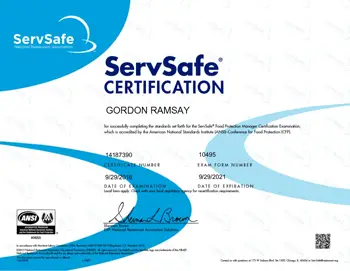Quick Tips for Efficiently Finishing Your ServSafe Food Handler Course Online
Quick Tips for Efficiently Finishing Your ServSafe Food Handler Course Online
Blog Article
Comprehensive Food Handlers Educating for Health and Safety
In today's swiftly advancing food service landscape, detailed food trainers training has arised as a critical part for making sure hygiene and security. By instilling vital techniques related to hand health, food storage, and cleanliness, this training not just alleviates the risk of foodborne ailments but also enhances conformity with governing requirements.
Value of Food Security Training

Furthermore, food security training aids to ensure that workers recognize existing laws and standards, which are important for preserving functional licenses and preventing pricey charges. Normal training sessions likewise offer as a platform for reinforcing best practices, consequently minimizing the possibility of human mistake, which typically serves as a leading reason for food contamination.
In addition, purchasing food security training can boost a facility's credibility, as customers increasingly focus on dining experiences that mirror high safety standards. Such proactive procedures not just secure consumers yet likewise add to the long-term success of food businesses. In recap, extensive food safety and security training is an essential aspect of food solution operations, straight affecting both public health and service sustainability.
Secret Principles of Hygiene
Keeping high requirements of hygiene is important in any kind of food handling atmosphere to stop contamination and guarantee the safety of consumers. The vital principles of health incorporate a number of critical practices that food trainers should constantly use.
First, hand hygiene is paramount; food handlers should wash their hands extensively with soap and water prior to and after managing food, along with after utilizing the toilet or touching any potentially infected surfaces. Devices and surfaces have to be consistently cleaned and sterilized to eliminate virus. This includes utensils, cutting boards, and counter tops, which must be preserved in a tidy condition.

Appropriate food storage is also essential; raw foods should be stored independently from prepared or ready-to-eat products to stay clear of cross-contamination. servsafe food handler. Additionally, keeping proper temperature level controls is crucial; perishable things should be maintained secure temperatures to inhibit bacterial development
Last but not least, individual hygiene can not be ignored. Food handlers must put on tidy clothing, usage hair restrictions, and stay clear of functioning when ill. By adhering to these key principles of health, food handlers can dramatically reduce the risk of foodborne illnesses and advertise a much safer dining experience for all consumers.
Usual Foodborne Health Problems
Although numerous foodborne diseases can be protected against with correct health and risk-free food taking care of techniques, they continue to be a substantial public health and wellness worry. Foodborne pathogens can lead to a variety of health problems, ranging from light click for more gastrointestinal distress to severe complications and even fatality.
Common foodborne illnesses include salmonellosis, brought on by Salmonella microorganisms, frequently linked to undercooked poultry and eggs. An additional common ailment is listeriosis, connected with raw milk items and ready-to-eat meats, which can be specifically harmful for immunocompromised people and additional info pregnant females. Norovirus, regularly contracted from infected food or surface areas, is known for its fast spread and capacity to create outbreaks in public settings.
Escherichia coli (E. coli) infection, significantly connected with undercooked hamburger and infected produce, can result in severe stomach cramps and kidney failure in some cases. In addition, Clostridium perfringens, typically discovered in huge quantities of food that are poorly kept, can cause gastrointestinal disorder with signs and symptoms appearing soon after intake.
Understanding these illnesses is critical for food trainers, as recognition can substantially decrease the risk of contamination and safeguard public wellness. Correct education and learning and training are crucial components in combating foodborne diseases.
Finest Practices for Food Handling
Effective food dealing with techniques are essential in avoiding the spread of foodborne illnesses. Firstly, appropriate hand health is vital; food trainers should wash their hands completely with soap and water before and after managing food, specifically raw meat or chicken - servsafe alcohol. This basic action dramatically lowers the threat of cross-contamination
Second of all, preserving proper food storage space temperature levels is important. Routinely sanitize countertops, cutting boards, and tools, especially after preparing raw foods. Usage different cutting boards for ready-to-eat and raw foods to even more reduce contamination threats.
Additionally, when preparing food, it is necessary to adhere to the principle of "very first in, initially out" (FIFO) to manage stock successfully and lower spoilage. Constantly adhere and read to food item tags for secure cooking temperatures and managing guidelines. By executing these ideal techniques, food handlers can dramatically improve food security and safeguard public wellness.
Executing a Security Culture
Producing a safety culture within a food taking care of environment is important for promoting a commitment to food security among all employee. This culture stresses the value of food safety as a shared duty, urging workers to prioritize health techniques consistently.
To implement a safety and security culture, organizations must begin by providing extensive training that deals with food handling procedures, prospective threats, and the importance of personal hygiene. Educating sessions ought to be interactive and tailored to the particular functions of personnel, ensuring significance and involvement.
In addition, leadership plays a critical duty in developing this culture. Monitoring ought to design safe practices and communicate the value of food security routinely. Acknowledging and rewarding employees that promote safety criteria can better reinforce these actions.
In addition, open communication networks must be established, allowing team to report safety problems without concern of effect. Regular security audits and comments sessions can help determine areas for enhancement and enhance accountability.
Eventually, growing a safety society not just improves conformity with food safety laws but also safeguards public wellness, cultivates worker spirits, and contributes to the total success of the food managing facility.
Verdict
Finally, comprehensive food trainers training plays a critical duty in advertising hygiene and safety and security within food service establishments. By gearing up employees with important expertise concerning food security principles, common foodborne diseases, and finest practices for taking care of food, such training considerably minimizes health risks. Fostering a culture of safety and security enhances the facility's credibility and straightens with consumer expectations for content high safety criteria, inevitably adding to public health and wellness protection and the overall success of the food solution sector.
In today's rapidly evolving food solution landscape, comprehensive food trainers training has actually emerged as an important element for making sure health and security.Food security training is crucial for maintaining high criteria in food handling and preparation, with researches indicating that correct training can lower foodborne health problems by up to 30%. In recap, comprehensive food safety training is an important component of food service operations, straight impacting both public health and company sustainability.

Report this page